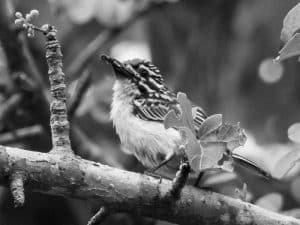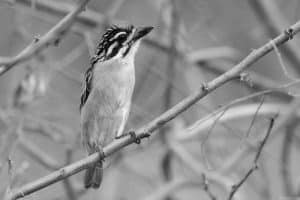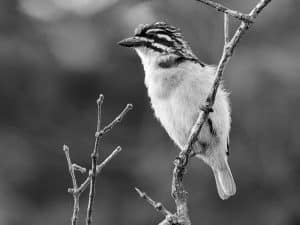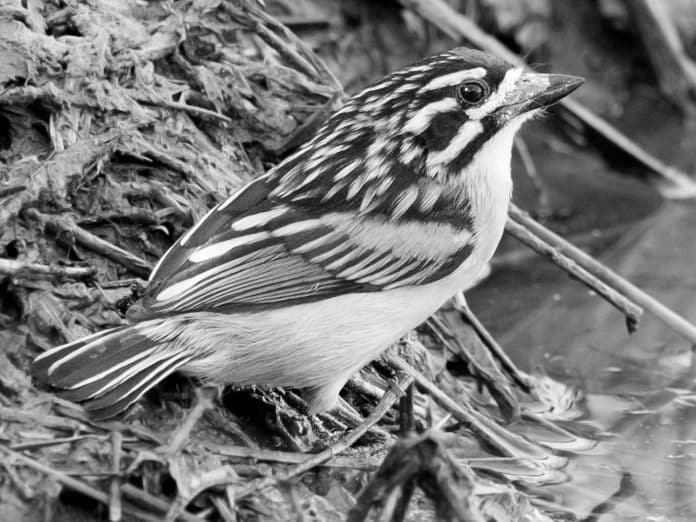Introduction to the Red-Fronted Barbet
Welcome to the mesmerizing world of the red-fronted barbet, a strikingly beautiful bird species that graces the horizons of Tanzania with its vibrant plumage and unique flight patterns. The red-fronted barbet in Tanzania, scientifically known as Tricholaema diademata, is a member of the African barbet family and is renowned for its distinctive crimson forehead and colorful feathers. These charismatic birds are a delight to observe in their natural habitat, and their presence enriches the diverse avian tapestry of Tanzania.

The red-fronted barbet’s appearance is truly captivating, with its deep red forehead, bold black eye stripe, and a blend of green, yellow, and red plumage that adorns its body. These medium-sized birds possess a stout, slightly curved bill that is perfectly adapted for their omnivorous diet, which includes fruits, insects, and seeds. Their melodious calls and lively behavior make them a sought-after sight for birdwatchers and nature enthusiasts visiting Tanzania.
The red-fronted barbet is an integral part of Tanzania’s rich avifauna, and its presence adds to the allure of the country’s diverse ecosystems. From the coastal regions to the lush forests and savannahs, these birds have carved out their niche in the natural landscapes of Tanzania, captivating the hearts of those fortunate enough to witness their graceful flights and vibrant displays.
Habitat and Distribution of the Red-Fronted Barbet in Tanzania
The red-fronted barbet is widely distributed across the eastern and southern regions of Africa, including Tanzania, where it can be found in a variety of habitats, ranging from coastal forests to montane and lowland forests. These adaptable birds are known to thrive in both primary and secondary forest areas, and they are often spotted in woodland edges, clearings, and riverine forests. Their ability to inhabit diverse environments contributes to their widespread presence in Tanzania, where they add a splash of color to the natural tapestry of the country’s landscapes.
In Tanzania, the red-fronted barbet can be found in the Usambara and Uluguru Mountains, where the lush montane forests provide an ideal habitat for these vibrant birds. They are also present in the coastal forests of eastern Tanzania, adding their vibrant hues to the rich biodiversity of the region. Additionally, the red-fronted barbet’s distribution extends into the southern highland forests, where their presence contributes to the ecological diversity of Tanzania’s diverse ecosystems.
The conservation of these vital habitats is crucial for the continued well-being of the red-fronted barbet population in Tanzania. Efforts to protect and preserve the forests and woodlands that serve as the home of these charismatic birds are essential for ensuring their continued presence in the country’s natural landscapes.
The Unique Flight Patterns of the Red-Fronted Barbet
One of the most captivating aspects of the red-fronted barbet is its unique flight patterns, which showcase the bird’s agility and grace as it navigates through the canopy and open spaces of its habitat. The distinctive wing beats of the red-fronted barbet, coupled with its vibrant plumage, make for a mesmerizing display that is a delight to behold.
When in flight, the red-fronted barbet’s striking colors come to life, creating a vivid spectacle against the backdrop of the forest or sky. Their agile maneuvers and darting flights add to the allure of these birds, making them a captivating subject for birdwatchers and photographers seeking to capture the beauty of Tanzania’s avian inhabitants.
The red-fronted barbet’s flight patterns are not only a visual delight but also serve a functional purpose in their daily lives. Their ability to navigate through the dense foliage and swiftly move between perches showcases their adaptability and agility, characteristics that contribute to their success as a species in Tanzania’s varied habitats.
Conservation Efforts for the Red-Fronted Barbet in Tanzania

The conservation of the red-fronted barbet and its natural habitats is of paramount importance to ensure the continued well-being of these charismatic birds in Tanzania. As with many avian species, the red-fronted barbet faces threats such as habitat loss, deforestation, and human encroachment, which necessitate concerted efforts to safeguard their populations and the ecosystems they rely on.
Conservation organizations and local authorities in Tanzania have been actively involved in initiatives aimed at protecting the habitats of the red-fronted barbet and mitigating the factors that pose risks to their survival. These efforts include habitat restoration, community engagement, and the establishment of protected areas to safeguard the environments that are crucial for the red-fronted barbet’s continued existence.
By raising awareness about the importance of preserving the habitats of the red-fronted barbet and implementing conservation measures, stakeholders in Tanzania are working towards securing a sustainable future for these vibrant birds. Through collaborative efforts and a commitment to environmental stewardship, the conservation of the red-fronted barbet in Tanzania is an ongoing endeavor that holds promise for the protection of this iconic species.
Best Locations for Birdwatching the Red-Fronted Barbet in Tanzania
For birdwatchers and nature enthusiasts seeking to catch a glimpse of the red-fronted barbet in its natural habitat, Tanzania offers a variety of prime locations where these vibrant birds can be observed. The Usambara and Uluguru Mountains are renowned for their diverse avian populations, and they provide excellent opportunities for spotting the red-fronted barbet amidst the lush montane forests that are characteristic of these regions.
The coastal forests of eastern Tanzania also offer favorable conditions for encountering the red-fronted barbet, with their rich biodiversity and vibrant avifauna creating a captivating backdrop for birdwatching experiences. Additionally, the southern highland forests of Tanzania provide a habitat for the red-fronted barbet, offering visitors the chance to observe these charismatic birds in their natural environment.
When planning a birdwatching excursion to observe the red-fronted barbet in Tanzania, it is advisable to seek guidance from local experts and experienced guides who are familiar with the best locations and optimal times for birdwatching. Their knowledge and insights can enhance the birdwatching experience and increase the likelihood of encountering the red-fronted barbet in its natural habitat.
Tips for Spotting and Photographing the Red-Fronted Barbet
Spotting and photographing the red-fronted barbet in Tanzania requires patience, keen observation, and an understanding of the bird’s behavior and habitat preferences. To maximize the chances of encountering these vibrant birds, it is beneficial to familiarize oneself with their distinctive calls, which can aid in locating their presence within the forested environments they inhabit.
When seeking to photograph the red-fronted barbet, it is essential to exercise caution and respect the bird’s natural behavior and surroundings. By employing stealth and maintaining a respectful distance, photographers can capture the beauty of the red-fronted barbet without causing disturbance or stress to the birds.
Additionally, understanding the red-fronted barbet’s feeding and nesting behaviors can provide valuable insights for spotting and photographing these birds in their natural habitat. By identifying their preferred food sources and nesting sites, birdwatchers and photographers can strategically position themselves to observe and capture the red-fronted barbet’s captivating displays.
The Role of the Red-Fronted Barbet in Tanzanian Ecosystems
As an integral part of Tanzania’s diverse ecosystems, the red-fronted barbet plays a significant role in the ecological balance of the country’s natural landscapes. Through their foraging activities, the red-fronted barbet contributes to seed dispersal and the maintenance of plant diversity, making them valuable agents in the regeneration and propagation of forest vegetation.
The red-fronted barbet’s presence also serves as an indicator of the health and vitality of the habitats they inhabit, offering insights into the ecological integrity of Tanzania’s forests and woodlands. By monitoring the populations and behaviors of the red-fronted barbet, conservationists and researchers gain valuable information about the status of the ecosystems where these birds reside.
Furthermore, the vibrant plumage and melodious calls of the red-fronted barbet add to the aesthetic appeal of Tanzania’s avian communities, enriching the natural heritage of the country and providing opportunities for ecotourism and nature-based recreation. Their presence contributes to the cultural and ecological tapestry of Tanzania, making them a cherished species within the country’s diverse ecosystems.
Threats to the Red-Fronted Barbet Population

Despite their resilience and adaptability, the red-fronted barbet faces a range of threats that jeopardize their populations in Tanzania. Habitat loss due to deforestation, agricultural expansion, and urban development poses a significant risk to the red-fronted barbet’s natural habitats, leading to fragmentation and degradation of the environments that are crucial for their survival.
Additionally, factors such as climate change, poaching, and human-wildlife conflict contribute to the challenges faced by the red-fronted barbet and other avian species in Tanzania. The cumulative impact of these threats underscores the urgency of conservation efforts aimed at protecting the red-fronted barbet and mitigating the factors that pose risks to their populations.
By addressing the root causes of these threats and implementing measures to safeguard the habitats and well-being of the red-fronted barbet, Tanzania can work towards securing a sustainable future for these vibrant birds and the ecosystems they inhabit.
Conclusion
In conclusion, the red-fronted barbet embodies the vibrant spirit of Tanzania’s avian biodiversity, enchanting observers with its striking plumage, unique flight patterns, and melodious calls. As stewards of the natural world, it is our collective responsibility to ensure the continued well-being of the red-fronted barbet and the habitats that sustain its populations.
By supporting conservation initiatives, raising awareness about the importance of preserving the natural environments of the red-fronted barbet, and advocating for sustainable practices that protect Tanzania’s diverse ecosystems, we can contribute to the long-term conservation of these charismatic birds.
Whether through participation in local conservation projects, engagement in ecotourism activities that promote responsible wildlife viewing, or support for organizations dedicated to avian conservation, each individual can make a meaningful difference in safeguarding the red-fronted barbet and the natural heritage of Tanzania.

































